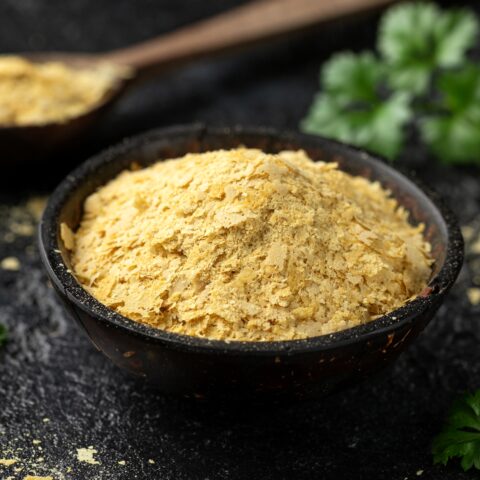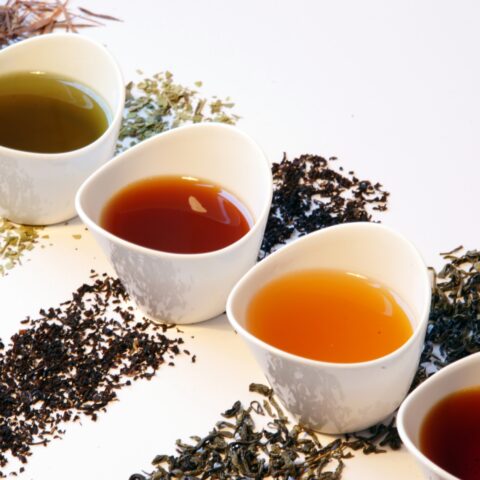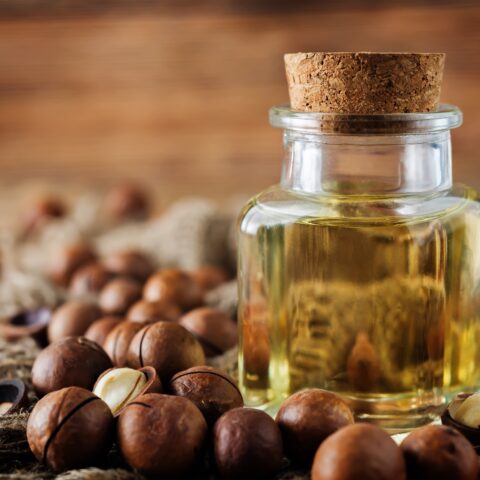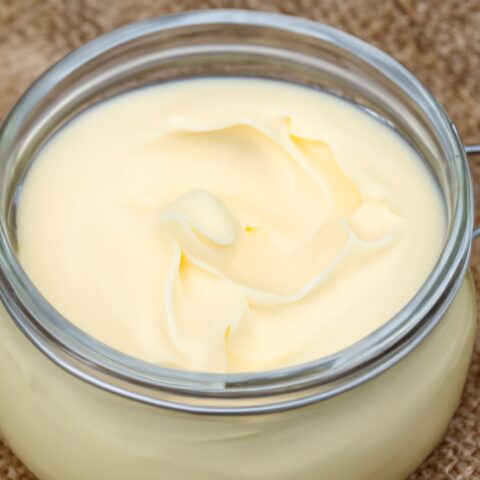Is Wine Good for You? Why Sulfites in Wine Are Unhealthy

Wondering if a glass of red or white wine is Paleo? The short answer is no. While there are certainly some types of wine that are healthier than others, we recommend that you keep any alcoholic beverages as part of your 15% in the 85/15 rule.
There are two major things to look out for when buying wine for those special occasions. First of all, look for wine with low levels of alcohol by volume. Be sure to stay hydrated when you’re drinking. And most importantly, keep an eye out for sulfites. These tricky little additives can wreak havoc on your health, but if you keep them to a minimum, you should have no trouble sticking to your Paleo health goals.
Before we get into the health effects of additives, let’s quickly dive into the background of winemaking.
Did Hunter-Gatherers Drink Wine?
From a purely factual perspective, no alcohol is Paleo. Our Stone Age ancestors simply lacked the technological means to produce either fermented or distilled drinks containing ethyl alcohol.1
As our species made the transition from the Paleolithic era (2.5 million years ago to 10,000 years ago) to the Neolithic era (10,000 to 5,000 years ago), the knowledge to produce fermented beverages containing low concentrations of ethanol became commonplace—and required minimal technology.2 – 5 However, the alcohol concentration in these beverages was low, and distilled spirits did not exist.4 Accordingly, the risk of alcohol abuse and diseases of alcoholism was likely low to non-existent.
How Is Wine Made?
Natural fermentation can spontaneously occur in fruit juices, fruit mashes, or fruit purees when airborne or other environmental yeasts contaminate the fruit products and metabolize the sugars in the fruit into alcohol. If the fermentation process (spoilage) is allowed to continue, the waste products of yeast metabolism of fruit sugars produce carbon dioxide and ethanol. Fruits high in sugar allow the yeast to produce beverages with higher alcoholic (ethanol) concentrations, but eventually increasing ethanol concentrations kill the very yeasts that produce it.
Wild grapes, which contain moderate to high sugar concentrations, would have been found throughout much of the Paleolithic world inhabited by hunter-gatherers.6 As such, it seems likely that wine became one of the first alcoholic beverages accidentally produced when grapes, whose skins are frequently contaminated with yeasts, were collected and mashed into a puree or juice and unintentionally left to ferment. Voila! Now we have wine, but it contained a much lower alcohol content than contemporary wines, and certainly not of the same quality.
The first archaeological evidence for deliberate winemaking occurred approximately 7,000 to 7,500 years ago,6 but it was likely closer to a millennium earlier, as people made the transition from hunter-gatherers to farmers in Europe and Asia and domesticated grapes.7 As winemaking progressed from the Neolithic times to the present, new production and manufacturing procedures were implemented to improve the taste, quality, and storage life of this beverage. However, this also meant the introduction of a questionable additive that nearly all modern wines possess: chemicals called sulfites.
Why You Should Avoid Sulfites in Wine
If you read your wine bottle labels carefully, you’ll likely find a note saying that it “Contains Sulfites.” Unfortunately, they don’t state the exact concentrations of sulfites in their wines, or advertise the adverse health effects may arise from ingestion of these chemicals. Look for wine bottles that advertise that it was made without added sulfites.
It should be noted that even wines produced without added sulfites actually maintain tiny amounts of these compounds, which result from the fermentation process itself. These tiny, residual quantities of sulfite probably don’t matter as much as the added kinds.
Sulfites also go by many different names. Here’s a laundry list of the most common sulfites:
- Sodium sulphite
- Sodium bisulphite
- Sodium metabisulphite
- Potassium sulphite
- Potassium bisulfite
- Potassium metabisulphite
- Calcium sulphite
- Calcium bisulfate
- Sulfur dioxide (which is not a sulfite, but rather a closely related oxide.)
Where Are Sulfites Hiding?
Wine isn’t the only place where you can find sulfites. They’re lurking in all kinds of foods and beverages, and it’s important to know where else you might find them.
Sulfites can also produce sulfur dioxide and other compounds, which may form free sulfites that attach to your food or drink.8 They are added to prevent the growth and oxidation of undesired species of bacteria, yeast, and other microorganisms in wine and foods, but can still cause problems on their own. Besides their antimicrobial action, sulfites are widely used in the food processing industry – predominantly as anti-browning agents, antioxidants, color stabilizers, and preservatives.9, 10 The following table11, 12 shows the concentration of total sulfites (bound and free) found in common beverages and foods.
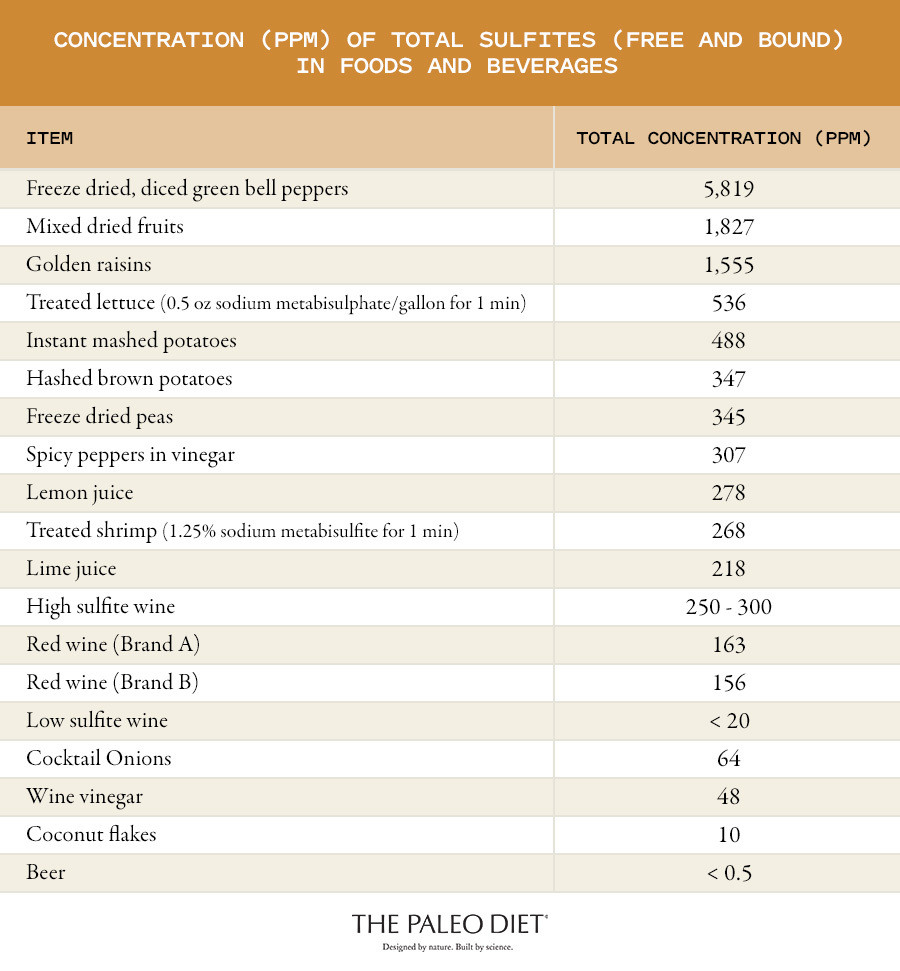
Weak Laws Regarding Sulfites
This list is certainly not comprehensive. The sulfite content of virtually all processed foods and beverages (including wine) is never reported on labels, simply because governmental agencies worldwide don’t require this information from manufacturers to be supplied to consumers. In the U.S. we are now burdened by four lame and obsolete laws regarding dietary sulfites which were enacted by the FDA some 26-28 years ago.13 – 16 In the first edict, the FDA simply required manufacturers to make the statement “Contains Sulfites” on food or beverage products that contained 10ppm or greater of total sulfites.13, 15 In the second statute, the FDA mandated that fresh fruits and vegetables could not be laced with sulfites.14, 16
Let’s take a look at what these two pieces of legislative fog actually mean to the typical consumer. The first portion states that whether a food contains 10ppm of sulfites or values approaching acceptable maximal daily limits for these chemicals (>0.7 mg per kg body weight), the labeling for the manufacturer for their product remains exactly the same – they must only state”Contains Sulfites.” 8, 13, 15
The second statute stipulates that fresh fruits and vegetables, such as in fresh supermarket produce or salad bars, cannot contain any added sulfites.14, 16 The rationale here is that merchants might keep their fruits and veggies on the shelf indefinitely by simply spraying or soaking these items with sulfites. In turn, consumers purchasing what they thought was fresh produce would actually be ingesting large amounts of sulfites in dated fruits and veggies. Hence, the USDA legislation actually had the consumer in mind by preventing excessive consumption of sulfites which even at the time (1986-88) were known to produce serious health concerns.
In theory, the FDA at this early juncture can’t necessarily be faulted, because they were taking steps to limit sulfite intake in the U.S. population.13 – 16 Unfortunately, no teeth were put into these governmental edicts to really make a difference. We are now saddled with weak laws that allow manufacturers of foods and beverages to sidestep the intent of this original legislation (lowering sulfite intake), and increase their company profitability by extending the shelf life of their products with added sulfites.
Health Issues of Added Sulfites
A number of recent reviews by internationally recognized experts who have studied the adverse health effects of added sulfites have concluded with the following statements:
“the clinical importance of sensitivities to these additives remains underestimated.”17
“Whilst the apparent safety of the sulphite additives lead to their widespread use, reports began to emerge during the 1970’s that sulphite exposure was associated with adverse reactions.” These included the triggering of anaphylactic reactions, as well as the elicitation of a wide range of symptoms, including dermatitis, urticaria, flushing, hypotension, abdominal pain and diarrhea… and the triggering of bronchoconstriction in asthmatic patients”18
“Currently, sulfiting agents are not considered GRAS for use in meats, foods recognized as a major source of vitamin B-1 (sulfites have been found to destroy thiamin), or fruits or vegetables intended to be served raw to consumers or to be presented to consumers as fresh.”19
“The analysis of specific consumption data confirmed the existence of a risk of exceeding the ADI (Acceptable Daily Intake) related to sulphite residue levels in wine.”20
If you have ever tipped more than three glasses of wine at a dinner, a celebration or for whatever reason, you most likely have experienced a “hangover” and most likely attributed these symptoms to “too much alcohol.” You are probably right—regardless of its source, acute, excessive ethanol consumption does damage to our physiology which on the short term causes a number of symptoms which we collectively refer to as a “hangover.” Many people experience hangover like symptoms, particularly after imbibing too much wine.
Wine is a potent source of dietary sulfites. A number of studies have concluded that the two major dietary sources of sulfites for adults are wine and dried, processed fruit.8, 20, 21 How much dietary sulfite is too much? Symptoms of sulfite toxicity with wine may occur when wines exceeding 150ppm (see the table above) are consumed, particularly when you drink more than 450ml.8, 12 A standard wine bottle contains 750ml, so if you drink 2-3 moderate glasses of wine, you can easily exceed 450ml.
Symptoms of sulfite toxicity are quite similar to being drunk or experiencing a hangover and include: flushing, fast heartbeat, stomach upset, diarrhea and abdominal pain. Further, excessive sulfite ingestion may cause hives, wheezing, dizziness, difficulty in swallowing, tingling in limbs and low blood pressure.17, 18 The greatest threat to health from sulfites is their aggravating effect upon pulmonary function in asthmatics (be they children or adults). It is estimated that 3-10% of all asthmatic patients are sensitive to sulfites and children with asthma appear to be at even a higher risk.18
The Bottom Line
Wine can be a delicious compliment for special meals. If you would like to treat yourself a glass, check out a sulfite-free wine, or if you’ve noticed a reaction after drinking wine, see if swapping to a brand with lower amounts of sulfites makes the difference for you. Just remember to keep wine and other alcoholic beverages as an occasional pleasure, and not part of your daily diet.
References
1. Cordain L, Eaton SB, Sebastian A, Mann N, Lindeberg S, Watkins BA, O’Keefe JH, Brand-Miller J. Origins and evolution of the Western diet: health implications for the 21st century. Am J Clin Nutr. 2005 Feb;81(2):341-54
2. Teramoto Y, Tktsuya Hano T, Ueda S. Production and characteristics of traditional alcoholic beverage made with sweet potato as the saccharifying agent. J Inst Brew, November-December 1998;104: 339-341
3. Henkel TW. Parakari, an indigenous fermented beverage using amylolytic Rhizopus in Guyana. Mycologia 2005;97:1-11.
4. Steinkraus KH. Nutritionally significant indigenous foods involving an alcoholic fermentation. In: Gastineau CF, Darby WJ, Turner TB (eds.) Fermented food beverages in nutrition. New York, Academic Press, 1979, pp 35-59.
5. Steinkraus KH. Handbook of Indigenous Fermented Foods (2nd ed.). New York, Marcel Dekker, 1996.
6. McGovern PE, Glusker DL, Exner LJ. Neolithic resinated wine. Nature 1996; 381:480-481.
7. Arroyo-García R, Ruiz-García L, Bolling L et al. Multiple origins of cultivated grapevine (Vitis vinifera L. ssp. sativa) based on chloroplast DNA polymorphisms. Molecular Ecology 2006;15: 3707-14.
8. Machado RD, McToledo, E Vincente.Sulfite content in some Brazilian wines: analytical determination and estimate of dietary exposure. European Food Research and Technology
July 2009, Volume 229, Issue 3, pp 383-389.
9. Roberts A, McWeeny D. The use of sulfur dioxide in the food industry. A review. J Fd Technol 1972;7:221-38.
10. Taylor Sl, Higley NA, Bush RK. Sulfites in foods: uses, analytical methods, residues, fate, exposure assessment, metabolism, toxicity, and hypersensitivity. Adv Food Res 1986;30:1-76.
11. Kim HJ, Park GY, Kim YK. Analysis of sulfites in foods by ion exclusion chromatography with electrochemical detection. Food Technol 1987;41:85-91.
12. Vally H, Carr A, El-Saleh J, Thompson P. Wine-induced asthma: a placebo-controlled assessment of its pathogenesis. J Allergy Clin Immunol. 1999 Jan;103(1 Pt 1):41-6.
13. FDA. 1986. Food labeling, Declaration of sulfiting agents. Food and Drug Admin, Fed. Reg 51:25012.
14. FDA. 1986. Sulfiting agents; Revocation of GRAS status for use on fruits and vegetables intended to be served or sold raw to consumers. Food and Drug Admin, Fed Reg. 51:25021 and 25198.
15. FDA. 1988. Sulfiting agents in standardized foods: Labeling requirements. Food and Drug Admin, Fed Reg. 53:51062-51084.
16. FDA. 1988. Sulfiting agents: Afirmation of GRAS status. Food and Drug Admin, Fed Reg. 53: 51065-51084.
17. Vally H, Misso NL, Madan V. Clinical effects of sulphite additives. Clin Exp Allergy. 2009 Nov;39(11):1643-51
18. Vally H, Misso NL. Adverse reactions to the sulphite additives. Gastroenterol Hepatol Bed Bench. 2012 Winter;5(1):16-23.
19. Grotheer P, Marshall M, Simonne A. Sulfites: separating fact from fiction. University of Florida, Institute of Food and Agricultural Sciences, 2005, //edis.ifas.ufl.edu
20. Leclercq C1, Molinaro MG, Piccinelli R, Baldini M, Arcella D, Stacchini P. Dietary intake exposure to sulphites in Italy—analytical determination of sulphite-containing foods and their combination into standard meals for adults and children. Food Addit Contam. 2000 Dec;17(12):979-89.
21. Urtiaga C1, Amiano P, Azpiri M, Alonso A, Dorronsoro M. Estimate of dietary exposure to sulphites in child and adult populations in the Basque Country. Food Addit Contam Part A Chem Anal Control Expo Risk Assess. 2013;30(12):2035-42.
Loren Cordain, Ph.D.
As a professor at Colorado State University, Dr. Loren Cordain developed The Paleo Diet® through decades of research and collaboration with fellow scientists around the world.
More About The Author
